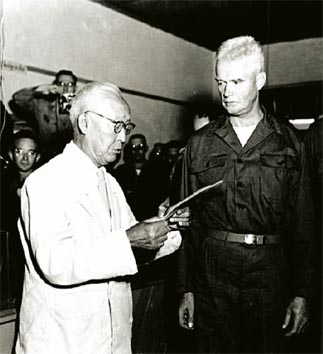HOW THE WAR BEGAN
Strategic success, at a dear price
Last week, General Paik described the lack of preparation for a well-planned, highly coordinated North Korean invasion inside the South Korean military.

A propaganda pamphlet distributed by the South and its allied forces during the Korean War tells citizens of the superior air power of the United States, with a picture of a U.S. P-80 jet fighter. Provided by Paik Sun-yup
“I have 10 years of experience under my belt in the artillery. I am not too worried about such enemies,” said the staff sergeant in a dismissive tone. Two days later, when we had arrived at Pyeongtaek, we saw the same elements in a hasty withdrawal mode. The North Koreans, with their superior numbers, had proven that they could match even the Americans’ excellent weapons.
Task Force Smith amounted to a total of 540 troops flown into Korea on June 30. Their main purpose was to be visible to the enemy, effectively advertising that the U.S. had entered the war in force. Their encounter with North Korean forces at Osan was a bloody one that quickly reflected the realities of war. On July 5, Task Force Smith fought a battle against some 5,000 North Koreans, mainly from the 107th regiment of the North’s 105th Tank Division. In this first official battle between the two forces, the U.S. side lost 20 men, while 130 were injured and another 36 were taken as prisoners.
There were mixed feelings about the rushed arrival of Task Force Smith. One side argued that the involvement of the unit was a success, while others said it was “premature.” Needless to say, Gen. MacArthur held the former opinion, while Gen. Matthew Ridgway was of the latter mind.
After the initial deployment of the task force, the remainder of the U.S. 24th Division was eventually deployed to the Korean Peninsula, and Daejeon was one of the first places that the unit chose to establish a defensive perimeter and put a halt to the general retreat that the task force had experienced until then.

President Syngman Rhee awards Maj. Gen. William Dean a citation after he had returned from captivity in North Korea in September 1953. Provided by Paik Sun-yup
From a tactical point of view, the deployment of the 24th Division was a failure. To deploy a force that had been without any proper training for a prolonged time to the theater was just not feasible. The moment Task Force Smith entered the war zone it never had an opportunity to establish itself but was constantly pushed back. The fact that Major General Dean was captured was also a loss to the Americans.
Nevertheless, from a strategic point of view there was some value to the presence of the hastily deployed division. The North Korean forces did have to halt, and their advance was delayed for some time. It was also a clear signal to the Soviet Union and North Korea that the United States had entered the war. South Korea also received a morale boost from the participation of the U.S.
Gen. MacArthur viewed the sacrifice of the 24th Division as justifiable in light of its overall strategic value, while Gen. Ridgway, who was more of a tactician, saw the involvement of an unprepared division as a waste of manpower. MacArthur saw the conflict as a battle between communism and the free world, while Ridgway was more concerned with the immediate losses to U.S. strength.
Major General Dean spent three years in captivity. I met him again in 1958 on a visit to the United States.
[estyle@joongang.co.kr]










with the Korea JoongAng Daily
To write comments, please log in to one of the accounts.
Standards Board Policy (0/250자)